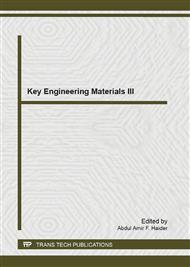p.125
p.131
p.136
p.141
p.145
p.150
p.154
p.163
p.167
Tunable Silver Leaching from Polyelectrolyte Multilayers Thin Films
Abstract:
Silver nanoparticles were deposited on glass slides and surgical suture as antibacterial agent. The silver nanoparticles were prepared by chemical reduction with sodium borohydride and using a synthetic polyelectrolyte as capping agent. Poly (4-styrenesulfonic acid-co-maleic acid) sodium salt PSSMA was used to stabilize the silver nanoparticles and provide an anionic surface charge which then allowed the layer-by-layer deposition method with poly (dially dimethyl ammonium chloride) PDADMAC. Various concentration of capping agent were used to prepare the silver nanoparticles which were then deposited on glass slide and surgical suture. The layer-by-layer deposition of the nanoparticles was studied using UV-Vis spectroscopy by monitoring the intensity of the characteristic Plasmon band of the nanoparticles at 400nm. The leaching of the silver nanoparticles in buffered solutions of pH 3,7 and 9 was monitored by recording the decrease in absorbance of silver nanoparticles film as a function of time for each pH solutions and each capping concentrations. Finally, suture material coated with silver nanoparticles were tested for their antibacterial activity against Staphylococcus aureus and results showed that all coated sutures had more than 99% bacterial reduction. So these suture material could be applied to use in medical products for promoted wound healing and decreased bacterial colony leading to relieve inflammation of patient.
Info:
Periodical:
Pages:
145-149
Citation:
Online since:
May 2013
Authors:
Keywords:
Price:
Сopyright:
© 2013 Trans Tech Publications Ltd. All Rights Reserved
Share:
Citation:


